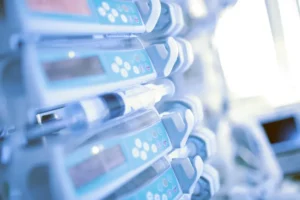The Role of Sensors in the Big Picture of Sustainability

The role of sensors has become increasingly significant in the healthcare ecosystem as the world becomes more connected, intelligent, and automated. (Credit: TE Connectivity)
In today’s landscape, sustainability has taken center stage. Technological advancements have made our world more connected than ever and companies everywhere, including those in the medical equipment industry, are focusing on how they can reduce their environmental impact.
Initiatives like energy reduction and decreased water usage have been pushed to the forefront. Additional efforts such as hazardous waste and operational waste diversion, optimized transportation methods, and greener product distribution, have also become top of mind for many companies. Finally, there has been a shift in thinking of how materials are handled and how they are recycled or reused, which contributes to a more sustainable product life cycle.
What does all of this have to do with sensors? Unbelievably, in the big picture of medical equipment sustainability, sensors play an important role. That’s right, something so miniature can have quite the impact on maintaining and improving sustainability — from the product design phase to use in equipment in the home.
Sustainable Sensor Product Design is Key to a Greener Future

Integrating sensors that use more eco-friendly materials can directly impact a medtech company’s sustainability progress. (Credit: TE Connectivity)
The role of sensors has become increasingly significant in the healthcare ecosystem as the world becomes more connected, intelligent, and automated. New sensor technologies are helping to lower costs, improve patient outcomes and better manage health conditions by enabling deeper data-driven decisions. Making sustainable progress starts by evaluating sensors themselves — their overall design and the materials used to create them. From an engineering perspective, first examine current products in a portfolio, dissecting them to even the smallest components, to determine how those products may be able to be adapted to be more sustainable. Perhaps a new eco-friendly material is available today versus years ago when the product was developed. If that is the case, a switch to that material could help reach sustainability targets as well as positively impact the bottom line if a cost savings is involved. Furthermore, some companies are investing strongly in product or material sustainability and a shift to working with them could be worthwhile.
During product development, it is critical for engineers to use the sustainability design tools at their disposal. Compared to years ago, engineers today have access to computer programs that can optimize product design to minimize material usage without compromising performance or robustness. Teams can create simulations of products that will cut down on CO2 emissions. Given the miniature size of sensors, oftentimes the decrease of CO2 will be kilograms, but it is crucial to remember that small gains add up over time.
One such example of a sustainability-engineered solution is the reformulation of sensors used in minimally invasive equipment. In this area, sterilization is vitally important, and most products are single use. To sterilize equipment in sections, hospitals and medical facilities typically use electron beam radiation. However, this process can ruin sensors. At TE, for example, engineers are working on technologies that protect sensors from radiation. In these cases, some products are now available for triple use versus single use.
Although a slight improvement, it has the potential for a great sustainability impact as it reduces waste as well as energy consumption from product creation.
A Driving Force in Sustainability
In recent years, the trend of home healthcare has become increasingly popular. Thanks to advanced sensors, devices such ranging from wearable fitness trackers to sophisticated home monitoring systems can improve access to care and potentially reduce the need for frequent visits to healthcare facilities.
How does this play into sustainability? Let’s take for instance the example of dialysis. Dialysis is a highly effective treatment that helps the body remove fluid and waste products from the blood when the kidneys cannot. Despite its effectiveness, dialysis is demanding for patients, often necessitating treatment three times per week, with each session lasting three to five hours.
The transition to home dialysis enables individuals to undergo treatment conveniently at home. From a sustainability perspective, the benefits are twofold. Dialysis machines use a myri.ad of sensors, including air bubble detection sensors, force sensors, pressure sensors, and temperature sensors, which are critical to operation and allow the dialysis machine to function optimally within the home environment. Designing these sensors using more eco-friendly materials, as mentioned above, can directly impact a company’s sustainability progress. But beyond that, home dialysis cuts down on travel times to and from doctor’s visits, effectively reducing carbon emissions. It also reduces the energy and resources required to operate dialysis centers and the waste generated at these facilities.
An Eco-Friendly Mindset Makes All the Difference
A sustainability mindset drives behaviors and decisions. Collaborating with employees, customers, and suppliers who value sustainability is key to measurable change. Luckily, for engineers currently entering school, sustainability is included in many of today’s educational curricula, so they are learning the importance of sustainable design from the beginning. Similarly, recent graduates are looking for companies that are committed to and actively pursuing greener solutions. Effective communication of sustainability progress is also crucial with customers and suppliers. Demonstrating the impacts of products and services can inspire others to reduce their carbon footprints.
Truth be told, sustainability is no longer a choice, but a must do. For example, TE has implemented several sustainability initiatives. Since 2020, the company has reduced absolute Scope 1 and Scope 2 greenhouse gas emissions directly generated by the company by 72 percent, and is committed to reducing indirect Scope 3 emissions, resulting from its value chain, by 30 percent by 2032. In the years ahead, TE expects to see even more sustainable sensor design as engineers work harder and smarter to bring new products to market. Healthcare will see even more treatments available in the home versus the hospi.tal, and sensor manufacturers must develop more sophisticated technologies to integrate with complex systems for IoT applications. With the right tools and the right mindset, even small wins can lead to collective gains paving the way for a more sustainable future.
Article source: Medical Design Briefs









